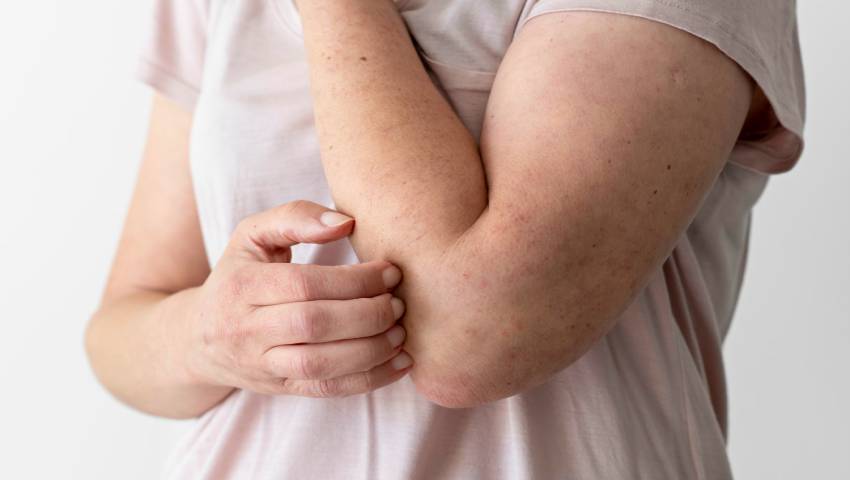
- 09/04/2025
- Dr. Kiran Ardad-Mane
- 0 Comments
- Dermatology
How to Prevent and Treat Heat Rashes in Summer
Summer brings with it warm weather, sunshine, and outdoor activities, but it can also bring skin troubles like heat rashes. Also known as prickly heat or miliaria, heat rash is a common skin condition that happens when sweat gets trapped in the sweat ducts, leading to inflammation and irritation. While it’s more common in babies and young children, adults are equally vulnerable, specifically during hot and humid weather.
At Leela Superspeciality Hospital, Dr. Kiran Ardad-Mane, a renowned dermatologist & cosmetologist in Pune, sees a sharp increase in cases of heat rashes during the summer months. The good news? Heat rash is usually preventable and can be treated effectively with a few simple changes to your routine. In this blog, we’ll discuss what heat rash is, what causes it, and most importantly, how to prevent and treat it.
What Is Heat Rash?
Heat rash, or prickly heat, happens when sweat gets trapped beneath the skin, causing inflammation and the formation of tiny red or pink bumps. It is most commonly seen in areas of the body where sweat tends to accumulate, such as the neck, back, chest, armpits, and groin. This condition is more prevalent during hot and humid weather, as excessive sweating contributes to the blockage of sweat glands.
What Causes Heat Rash?
The main reasons behind heat rash include:
- Hot and humid weather
- Wearing tight or non-breathable clothing
- Excessive sweating due to physical activity or hot environments
- Prolonged bed rest or fever
- Heavy creams or ointments that block sweat glands
Infants and toddlers are especially at risk due to their underdeveloped sweat glands, but adults can also experience it, specifically in skin folds, under the breasts, in the groin area, and back.
Symptoms of Heat Rash:
If you’re unsure whether that itchy red rash is heat-related, watch for these symptoms:
- Red or pink rashes or clusters of small bumps
- Itching or a “prickly” sensation
- Mild swelling or tenderness
- Increased discomfort in heat or after sweating
- Sometimes pus-filled bumps if the rash becomes infected
How to Prevent Heat Rash:
According to Dr. Kiran Ardad-Mane, prevention is always better than cure, specifically in the case of heat rashes. Here are expert-recommended tips to avoid the discomfort of prickly heat:
Stay Cool:
- Avoid excessive heat exposure.
- Use fans or air conditioners during extremely hot days.
- Take cool showers to decrease body temperature and cleanse sweat.
Wear Breathable Clothing:
- Choose light, loose-fitting cotton clothes.
- Avoid synthetic fabrics that trap heat and moisture.
Keep Skin Dry:
- Use talcum powder or medicated body powders to absorb moisture.
- Dry off sweat regularly using a clean towel.
- Change sweaty clothes promptly.
Avoid Heavy Creams and Ointments:
- Oil-based lotions can block sweat ducts. Choose water-based, non-comedogenic moisturizers.
- Avoid overuse of cosmetic products during peak summer hours.
Stay Hydrated:
- Drink plenty of water to help your body regulate temperature and prevent excessive sweating.
Limit Physical Activity During Peak Hours:
- Exercise earlier in the morning or late in the evening when temperatures are cooler.
- Take breaks and rest in shaded or cool places.
Treatment for Heat Rash:
If you already have a heat rash, don’t worry, it can usually be treated at home. Here are some effective treatment methods recommended by the best heat rash specialist in Pune, Dr. Kiran Ardad-Mane:
Cool Compresses:
- Apply a cold, moist cloth to the affected area for 10–15 minutes.
- Helps decrease inflammation and relieve itching.
Keep the Area Dry and Clean:
- Gently wash with cool water and mild soap.
- Pat the area dry—avoid rubbing.
Calamine Lotion or Aloe Vera Gel:
- These soothe irritated skin and reduce itching.
- Aloe vera also has cooling and anti-inflammatory properties.
Topical Steroids (Only If Prescribed):
- For severe rashes, a mild corticosteroid cream may be advised by your dermatologist.
- Always use under medical supervision to avoid side effects.
Antihistamines (If Itchy):
- If the rash is very itchy, antihistamines can provide relief.
- Consult a doctor before taking any medication.
When to See a Doctor:
While most cases of heat rash are mild and self-limiting, there are instances when medical attention may be essential. Seek professional help if:
- The rash does not improve with home care.
- The rash becomes infected, showing signs of redness, swelling, or pus.
- You experience fever or chills along with the rash.
- The rash extends to other parts of the body.
- There is significant pain or discomfort associated with the rash.
Dr. Kiran Ardad-Mane emphasizes that persistent or recurrent rashes may indicate another underlying skin issue or infection and should be professionally evaluated.
Conclusion:
Heat rashes, though uncomfortable, are preventable and treatable. Staying cool, dry, and clean is the key to avoiding them. By following simple lifestyle changes and being aware of your skin’s needs during the hot season, you can enjoy summer safely.
If you experience persistent or severe heat rashes, don’t ignore the symptoms. Visit Leela Superspeciality Hospital, where Dr. Kiran Ardad-Mane offers expert dermatological care tailored to your skin type and condition. With the right treatment and preventive care, you can beat the heat without the rash.
Stay cool, stay safe, and give your skin the care it deserves this summer.

